Impact of Solar Energy on the Environment: A Comprehensive Study
VerifiedAdded on 2023/01/04
|8
|2314
|63
Essay
AI Summary
This essay examines the multifaceted environmental impacts of solar energy. It begins by highlighting the benefits of solar power, such as its role in reducing greenhouse gas emissions and promoting energy security. The essay then delves into the potential negative consequences, including the use of hazardous materials in solar panel production and the land use requirements of solar farms. The analysis covers various aspects, including the reduction of fossil fuel reliance, the impact on wildlife habitats, and the overall sustainability of solar energy. Furthermore, it discusses the economic aspects, emphasizing the affordability of solar energy and its potential to provide electricity to remote areas. The essay integrates information from various sources, including research articles and government reports, to provide a comprehensive overview of solar energy's environmental effects. It also touches upon the technological advancements, the potential for innovation, and the importance of considering both positive and negative impacts for a balanced perspective.

Running head: USE OF SOLAR ENERGY AND ITS IMPACT ON THE ENVIRONMENT SYSTEM
Use of solar energy and its impact on the environment system
Name of the Student:
Name of the University:
Authors note:
Use of solar energy and its impact on the environment system
Name of the Student:
Name of the University:
Authors note:
Paraphrase This Document
Need a fresh take? Get an instant paraphrase of this document with our AI Paraphraser
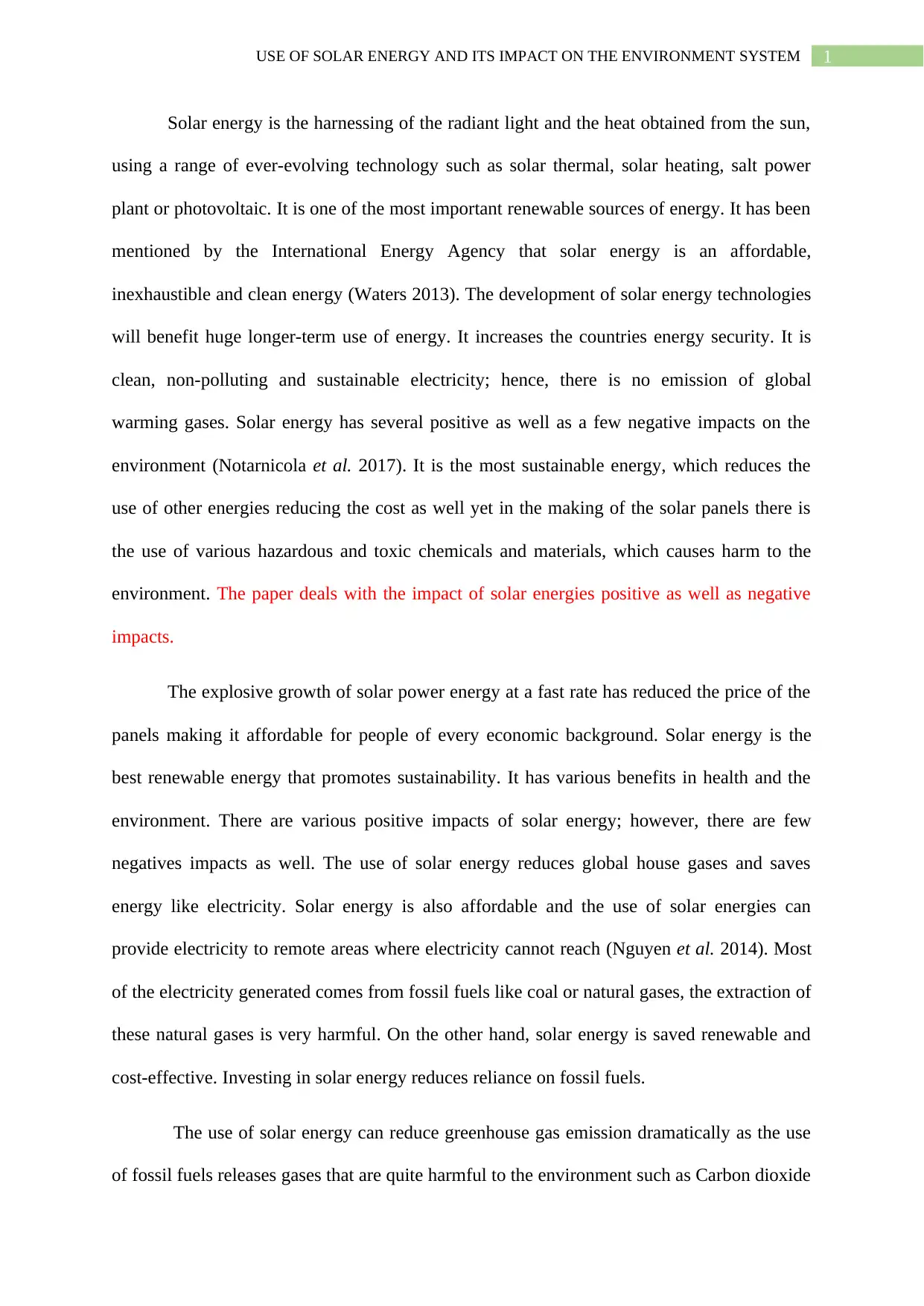
1USE OF SOLAR ENERGY AND ITS IMPACT ON THE ENVIRONMENT SYSTEM
Solar energy is the harnessing of the radiant light and the heat obtained from the sun,
using a range of ever-evolving technology such as solar thermal, solar heating, salt power
plant or photovoltaic. It is one of the most important renewable sources of energy. It has been
mentioned by the International Energy Agency that solar energy is an affordable,
inexhaustible and clean energy (Waters 2013). The development of solar energy technologies
will benefit huge longer-term use of energy. It increases the countries energy security. It is
clean, non-polluting and sustainable electricity; hence, there is no emission of global
warming gases. Solar energy has several positive as well as a few negative impacts on the
environment (Notarnicola et al. 2017). It is the most sustainable energy, which reduces the
use of other energies reducing the cost as well yet in the making of the solar panels there is
the use of various hazardous and toxic chemicals and materials, which causes harm to the
environment. The paper deals with the impact of solar energies positive as well as negative
impacts.
The explosive growth of solar power energy at a fast rate has reduced the price of the
panels making it affordable for people of every economic background. Solar energy is the
best renewable energy that promotes sustainability. It has various benefits in health and the
environment. There are various positive impacts of solar energy; however, there are few
negatives impacts as well. The use of solar energy reduces global house gases and saves
energy like electricity. Solar energy is also affordable and the use of solar energies can
provide electricity to remote areas where electricity cannot reach (Nguyen et al. 2014). Most
of the electricity generated comes from fossil fuels like coal or natural gases, the extraction of
these natural gases is very harmful. On the other hand, solar energy is saved renewable and
cost-effective. Investing in solar energy reduces reliance on fossil fuels.
The use of solar energy can reduce greenhouse gas emission dramatically as the use
of fossil fuels releases gases that are quite harmful to the environment such as Carbon dioxide
Solar energy is the harnessing of the radiant light and the heat obtained from the sun,
using a range of ever-evolving technology such as solar thermal, solar heating, salt power
plant or photovoltaic. It is one of the most important renewable sources of energy. It has been
mentioned by the International Energy Agency that solar energy is an affordable,
inexhaustible and clean energy (Waters 2013). The development of solar energy technologies
will benefit huge longer-term use of energy. It increases the countries energy security. It is
clean, non-polluting and sustainable electricity; hence, there is no emission of global
warming gases. Solar energy has several positive as well as a few negative impacts on the
environment (Notarnicola et al. 2017). It is the most sustainable energy, which reduces the
use of other energies reducing the cost as well yet in the making of the solar panels there is
the use of various hazardous and toxic chemicals and materials, which causes harm to the
environment. The paper deals with the impact of solar energies positive as well as negative
impacts.
The explosive growth of solar power energy at a fast rate has reduced the price of the
panels making it affordable for people of every economic background. Solar energy is the
best renewable energy that promotes sustainability. It has various benefits in health and the
environment. There are various positive impacts of solar energy; however, there are few
negatives impacts as well. The use of solar energy reduces global house gases and saves
energy like electricity. Solar energy is also affordable and the use of solar energies can
provide electricity to remote areas where electricity cannot reach (Nguyen et al. 2014). Most
of the electricity generated comes from fossil fuels like coal or natural gases, the extraction of
these natural gases is very harmful. On the other hand, solar energy is saved renewable and
cost-effective. Investing in solar energy reduces reliance on fossil fuels.
The use of solar energy can reduce greenhouse gas emission dramatically as the use
of fossil fuels releases gases that are quite harmful to the environment such as Carbon dioxide
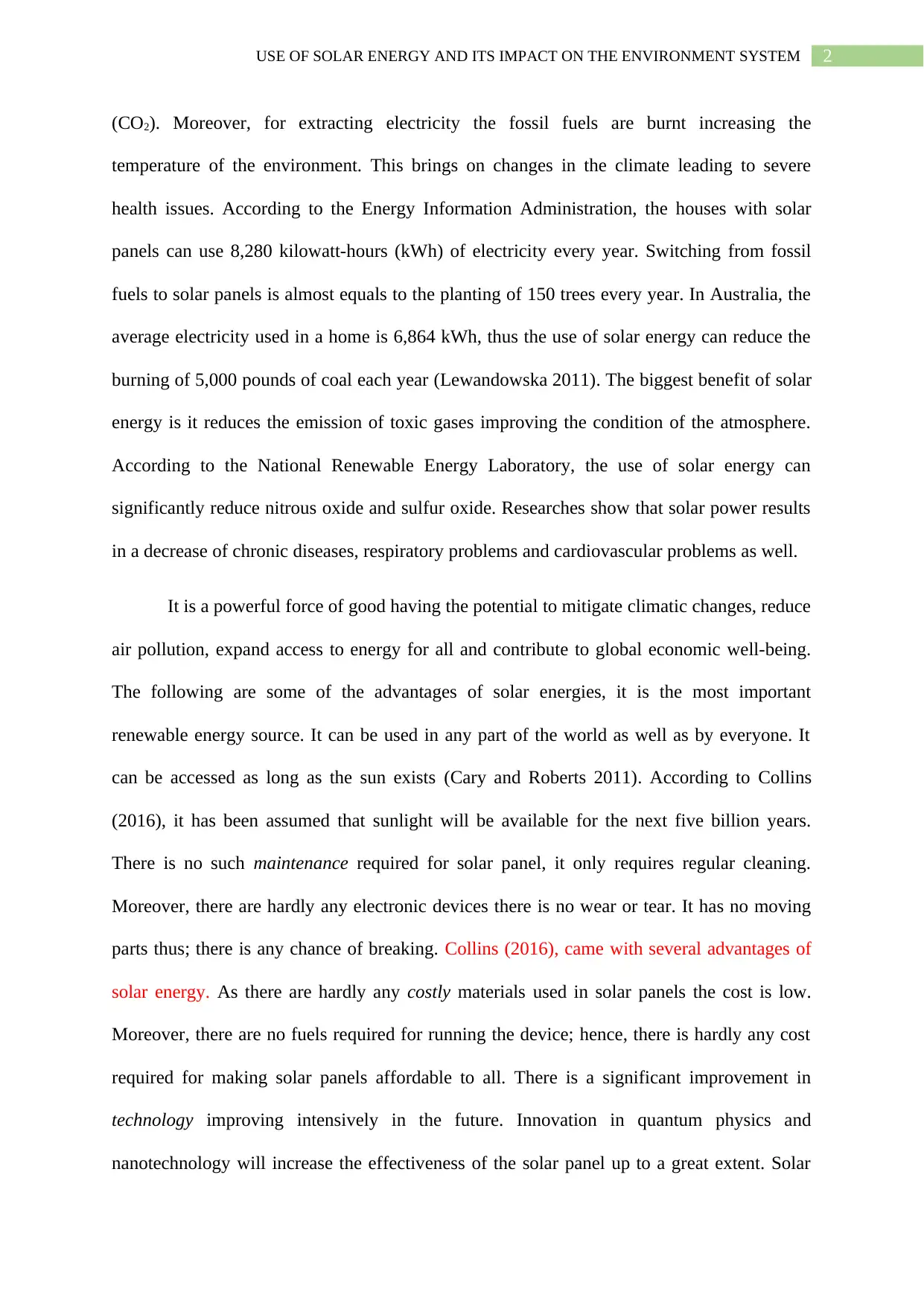
2USE OF SOLAR ENERGY AND ITS IMPACT ON THE ENVIRONMENT SYSTEM
(CO2). Moreover, for extracting electricity the fossil fuels are burnt increasing the
temperature of the environment. This brings on changes in the climate leading to severe
health issues. According to the Energy Information Administration, the houses with solar
panels can use 8,280 kilowatt-hours (kWh) of electricity every year. Switching from fossil
fuels to solar panels is almost equals to the planting of 150 trees every year. In Australia, the
average electricity used in a home is 6,864 kWh, thus the use of solar energy can reduce the
burning of 5,000 pounds of coal each year (Lewandowska 2011). The biggest benefit of solar
energy is it reduces the emission of toxic gases improving the condition of the atmosphere.
According to the National Renewable Energy Laboratory, the use of solar energy can
significantly reduce nitrous oxide and sulfur oxide. Researches show that solar power results
in a decrease of chronic diseases, respiratory problems and cardiovascular problems as well.
It is a powerful force of good having the potential to mitigate climatic changes, reduce
air pollution, expand access to energy for all and contribute to global economic well-being.
The following are some of the advantages of solar energies, it is the most important
renewable energy source. It can be used in any part of the world as well as by everyone. It
can be accessed as long as the sun exists (Cary and Roberts 2011). According to Collins
(2016), it has been assumed that sunlight will be available for the next five billion years.
There is no such maintenance required for solar panel, it only requires regular cleaning.
Moreover, there are hardly any electronic devices there is no wear or tear. It has no moving
parts thus; there is any chance of breaking. Collins (2016), came with several advantages of
solar energy. As there are hardly any costly materials used in solar panels the cost is low.
Moreover, there are no fuels required for running the device; hence, there is hardly any cost
required for making solar panels affordable to all. There is a significant improvement in
technology improving intensively in the future. Innovation in quantum physics and
nanotechnology will increase the effectiveness of the solar panel up to a great extent. Solar
(CO2). Moreover, for extracting electricity the fossil fuels are burnt increasing the
temperature of the environment. This brings on changes in the climate leading to severe
health issues. According to the Energy Information Administration, the houses with solar
panels can use 8,280 kilowatt-hours (kWh) of electricity every year. Switching from fossil
fuels to solar panels is almost equals to the planting of 150 trees every year. In Australia, the
average electricity used in a home is 6,864 kWh, thus the use of solar energy can reduce the
burning of 5,000 pounds of coal each year (Lewandowska 2011). The biggest benefit of solar
energy is it reduces the emission of toxic gases improving the condition of the atmosphere.
According to the National Renewable Energy Laboratory, the use of solar energy can
significantly reduce nitrous oxide and sulfur oxide. Researches show that solar power results
in a decrease of chronic diseases, respiratory problems and cardiovascular problems as well.
It is a powerful force of good having the potential to mitigate climatic changes, reduce
air pollution, expand access to energy for all and contribute to global economic well-being.
The following are some of the advantages of solar energies, it is the most important
renewable energy source. It can be used in any part of the world as well as by everyone. It
can be accessed as long as the sun exists (Cary and Roberts 2011). According to Collins
(2016), it has been assumed that sunlight will be available for the next five billion years.
There is no such maintenance required for solar panel, it only requires regular cleaning.
Moreover, there are hardly any electronic devices there is no wear or tear. It has no moving
parts thus; there is any chance of breaking. Collins (2016), came with several advantages of
solar energy. As there are hardly any costly materials used in solar panels the cost is low.
Moreover, there are no fuels required for running the device; hence, there is hardly any cost
required for making solar panels affordable to all. There is a significant improvement in
technology improving intensively in the future. Innovation in quantum physics and
nanotechnology will increase the effectiveness of the solar panel up to a great extent. Solar
⊘ This is a preview!⊘
Do you want full access?
Subscribe today to unlock all pages.

Trusted by 1+ million students worldwide
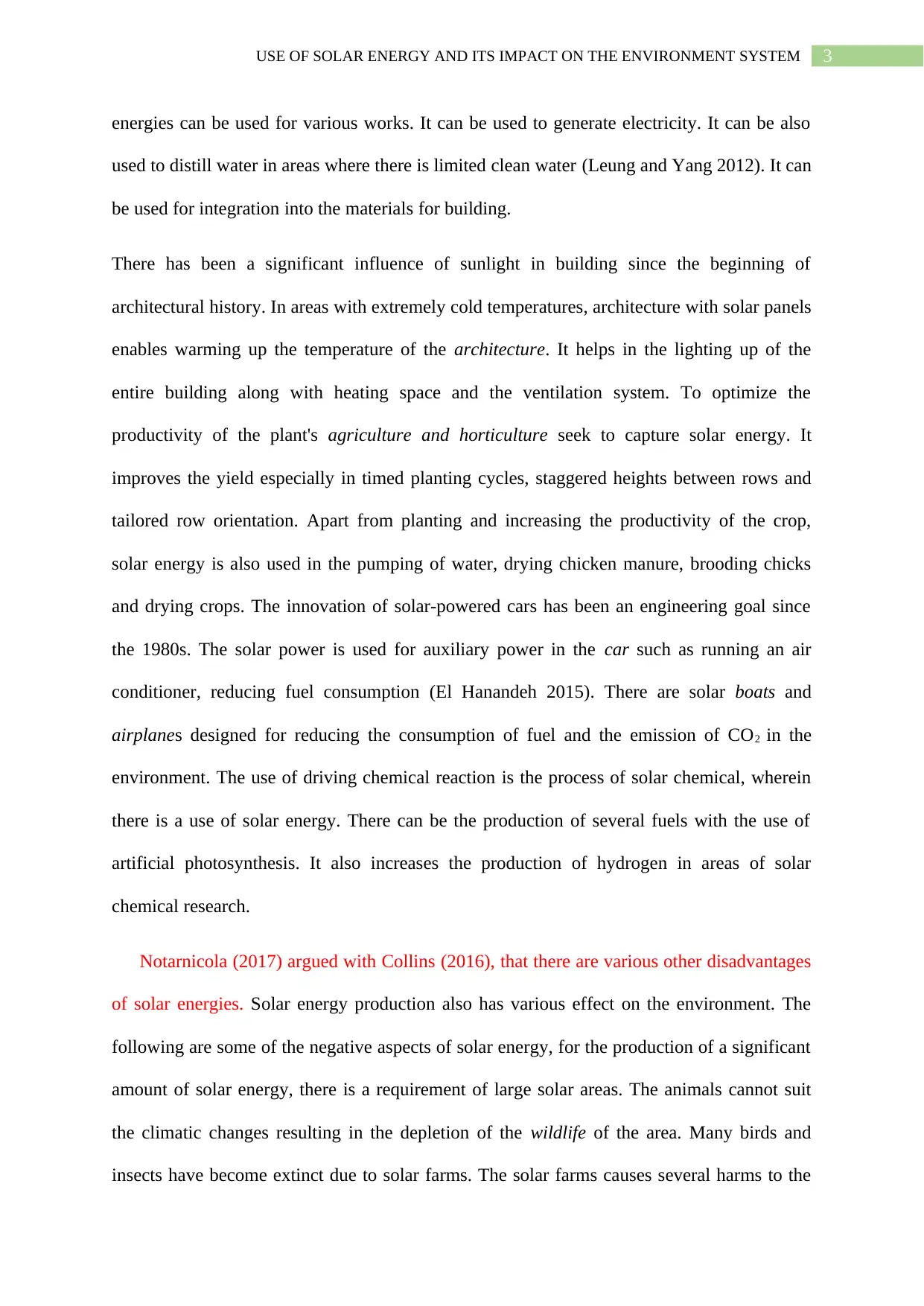
3USE OF SOLAR ENERGY AND ITS IMPACT ON THE ENVIRONMENT SYSTEM
energies can be used for various works. It can be used to generate electricity. It can be also
used to distill water in areas where there is limited clean water (Leung and Yang 2012). It can
be used for integration into the materials for building.
There has been a significant influence of sunlight in building since the beginning of
architectural history. In areas with extremely cold temperatures, architecture with solar panels
enables warming up the temperature of the architecture. It helps in the lighting up of the
entire building along with heating space and the ventilation system. To optimize the
productivity of the plant's agriculture and horticulture seek to capture solar energy. It
improves the yield especially in timed planting cycles, staggered heights between rows and
tailored row orientation. Apart from planting and increasing the productivity of the crop,
solar energy is also used in the pumping of water, drying chicken manure, brooding chicks
and drying crops. The innovation of solar-powered cars has been an engineering goal since
the 1980s. The solar power is used for auxiliary power in the car such as running an air
conditioner, reducing fuel consumption (El Hanandeh 2015). There are solar boats and
airplanes designed for reducing the consumption of fuel and the emission of CO2 in the
environment. The use of driving chemical reaction is the process of solar chemical, wherein
there is a use of solar energy. There can be the production of several fuels with the use of
artificial photosynthesis. It also increases the production of hydrogen in areas of solar
chemical research.
Notarnicola (2017) argued with Collins (2016), that there are various other disadvantages
of solar energies. Solar energy production also has various effect on the environment. The
following are some of the negative aspects of solar energy, for the production of a significant
amount of solar energy, there is a requirement of large solar areas. The animals cannot suit
the climatic changes resulting in the depletion of the wildlife of the area. Many birds and
insects have become extinct due to solar farms. The solar farms causes several harms to the
energies can be used for various works. It can be used to generate electricity. It can be also
used to distill water in areas where there is limited clean water (Leung and Yang 2012). It can
be used for integration into the materials for building.
There has been a significant influence of sunlight in building since the beginning of
architectural history. In areas with extremely cold temperatures, architecture with solar panels
enables warming up the temperature of the architecture. It helps in the lighting up of the
entire building along with heating space and the ventilation system. To optimize the
productivity of the plant's agriculture and horticulture seek to capture solar energy. It
improves the yield especially in timed planting cycles, staggered heights between rows and
tailored row orientation. Apart from planting and increasing the productivity of the crop,
solar energy is also used in the pumping of water, drying chicken manure, brooding chicks
and drying crops. The innovation of solar-powered cars has been an engineering goal since
the 1980s. The solar power is used for auxiliary power in the car such as running an air
conditioner, reducing fuel consumption (El Hanandeh 2015). There are solar boats and
airplanes designed for reducing the consumption of fuel and the emission of CO2 in the
environment. The use of driving chemical reaction is the process of solar chemical, wherein
there is a use of solar energy. There can be the production of several fuels with the use of
artificial photosynthesis. It also increases the production of hydrogen in areas of solar
chemical research.
Notarnicola (2017) argued with Collins (2016), that there are various other disadvantages
of solar energies. Solar energy production also has various effect on the environment. The
following are some of the negative aspects of solar energy, for the production of a significant
amount of solar energy, there is a requirement of large solar areas. The animals cannot suit
the climatic changes resulting in the depletion of the wildlife of the area. Many birds and
insects have become extinct due to solar farms. The solar farms causes several harms to the
Paraphrase This Document
Need a fresh take? Get an instant paraphrase of this document with our AI Paraphraser
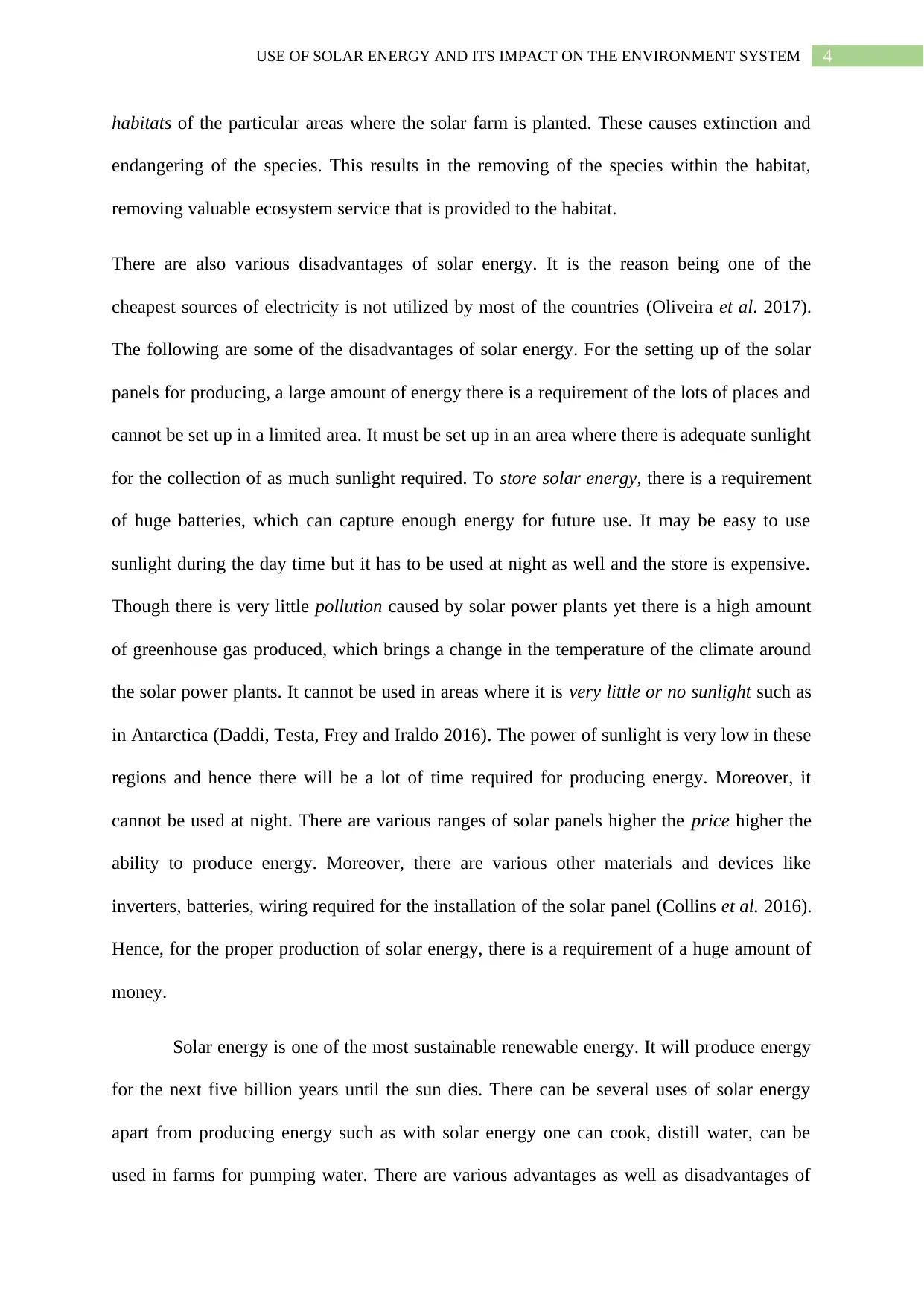
4USE OF SOLAR ENERGY AND ITS IMPACT ON THE ENVIRONMENT SYSTEM
habitats of the particular areas where the solar farm is planted. These causes extinction and
endangering of the species. This results in the removing of the species within the habitat,
removing valuable ecosystem service that is provided to the habitat.
There are also various disadvantages of solar energy. It is the reason being one of the
cheapest sources of electricity is not utilized by most of the countries (Oliveira et al. 2017).
The following are some of the disadvantages of solar energy. For the setting up of the solar
panels for producing, a large amount of energy there is a requirement of the lots of places and
cannot be set up in a limited area. It must be set up in an area where there is adequate sunlight
for the collection of as much sunlight required. To store solar energy, there is a requirement
of huge batteries, which can capture enough energy for future use. It may be easy to use
sunlight during the day time but it has to be used at night as well and the store is expensive.
Though there is very little pollution caused by solar power plants yet there is a high amount
of greenhouse gas produced, which brings a change in the temperature of the climate around
the solar power plants. It cannot be used in areas where it is very little or no sunlight such as
in Antarctica (Daddi, Testa, Frey and Iraldo 2016). The power of sunlight is very low in these
regions and hence there will be a lot of time required for producing energy. Moreover, it
cannot be used at night. There are various ranges of solar panels higher the price higher the
ability to produce energy. Moreover, there are various other materials and devices like
inverters, batteries, wiring required for the installation of the solar panel (Collins et al. 2016).
Hence, for the proper production of solar energy, there is a requirement of a huge amount of
money.
Solar energy is one of the most sustainable renewable energy. It will produce energy
for the next five billion years until the sun dies. There can be several uses of solar energy
apart from producing energy such as with solar energy one can cook, distill water, can be
used in farms for pumping water. There are various advantages as well as disadvantages of
habitats of the particular areas where the solar farm is planted. These causes extinction and
endangering of the species. This results in the removing of the species within the habitat,
removing valuable ecosystem service that is provided to the habitat.
There are also various disadvantages of solar energy. It is the reason being one of the
cheapest sources of electricity is not utilized by most of the countries (Oliveira et al. 2017).
The following are some of the disadvantages of solar energy. For the setting up of the solar
panels for producing, a large amount of energy there is a requirement of the lots of places and
cannot be set up in a limited area. It must be set up in an area where there is adequate sunlight
for the collection of as much sunlight required. To store solar energy, there is a requirement
of huge batteries, which can capture enough energy for future use. It may be easy to use
sunlight during the day time but it has to be used at night as well and the store is expensive.
Though there is very little pollution caused by solar power plants yet there is a high amount
of greenhouse gas produced, which brings a change in the temperature of the climate around
the solar power plants. It cannot be used in areas where it is very little or no sunlight such as
in Antarctica (Daddi, Testa, Frey and Iraldo 2016). The power of sunlight is very low in these
regions and hence there will be a lot of time required for producing energy. Moreover, it
cannot be used at night. There are various ranges of solar panels higher the price higher the
ability to produce energy. Moreover, there are various other materials and devices like
inverters, batteries, wiring required for the installation of the solar panel (Collins et al. 2016).
Hence, for the proper production of solar energy, there is a requirement of a huge amount of
money.
Solar energy is one of the most sustainable renewable energy. It will produce energy
for the next five billion years until the sun dies. There can be several uses of solar energy
apart from producing energy such as with solar energy one can cook, distill water, can be
used in farms for pumping water. There are various advantages as well as disadvantages of

5USE OF SOLAR ENERGY AND ITS IMPACT ON THE ENVIRONMENT SYSTEM
solar energy. Often there are misconceptions that solar energy does not affect the
environment. There are numerous benefits of solar energies yet there are also disadvantages
and effects of solar energies in the environment. However, among other energies solar energy
in one of the cheapest and effective energies with minimum effect on the environment. The
use of solar energy can lead to various other innovations and with other innovations and
excessive use of solar panels there can be a decrease in the cost of the panels.
solar energy. Often there are misconceptions that solar energy does not affect the
environment. There are numerous benefits of solar energies yet there are also disadvantages
and effects of solar energies in the environment. However, among other energies solar energy
in one of the cheapest and effective energies with minimum effect on the environment. The
use of solar energy can lead to various other innovations and with other innovations and
excessive use of solar panels there can be a decrease in the cost of the panels.
⊘ This is a preview!⊘
Do you want full access?
Subscribe today to unlock all pages.

Trusted by 1+ million students worldwide
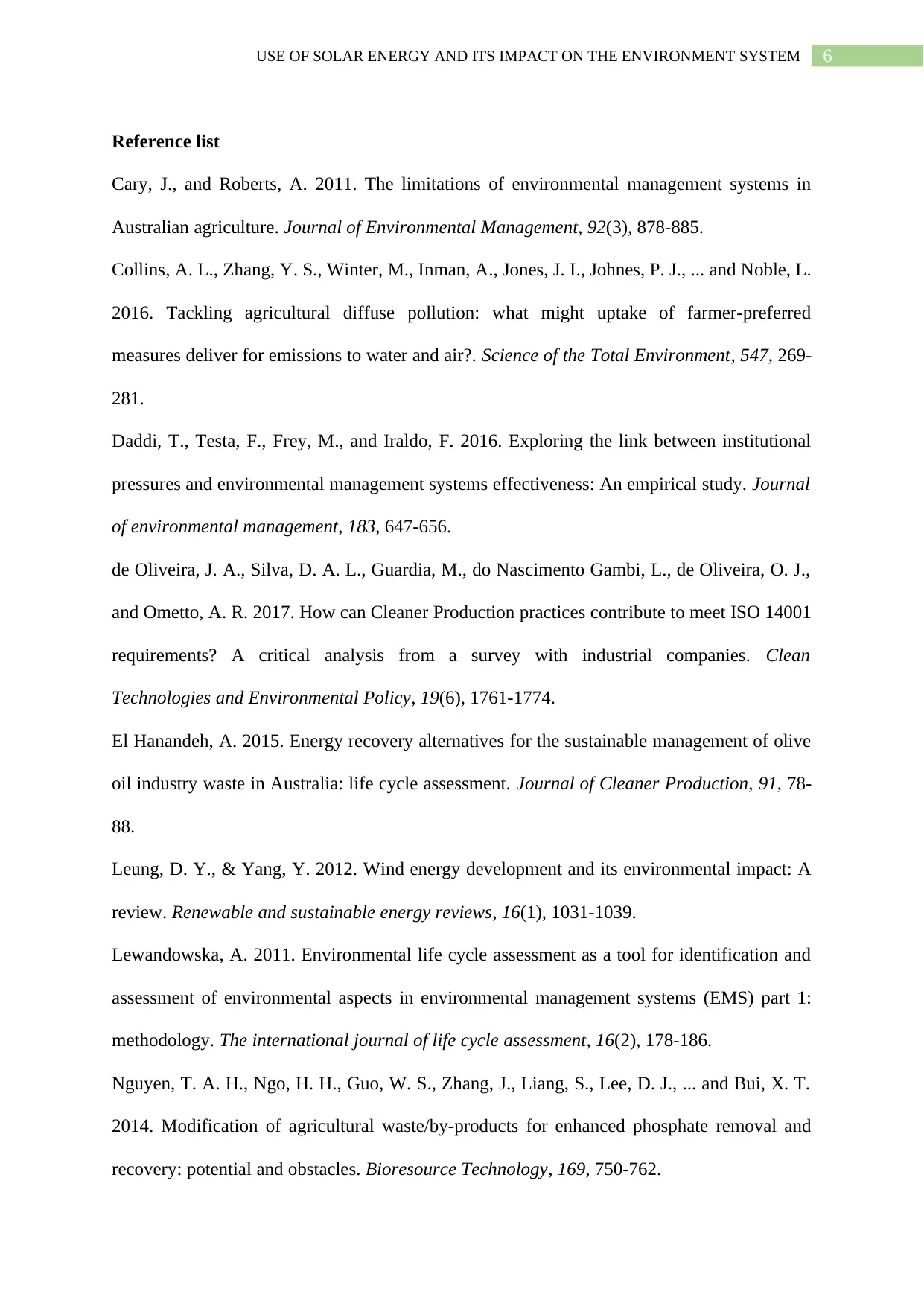
6USE OF SOLAR ENERGY AND ITS IMPACT ON THE ENVIRONMENT SYSTEM
Reference list
Cary, J., and Roberts, A. 2011. The limitations of environmental management systems in
Australian agriculture. Journal of Environmental Management, 92(3), 878-885.
Collins, A. L., Zhang, Y. S., Winter, M., Inman, A., Jones, J. I., Johnes, P. J., ... and Noble, L.
2016. Tackling agricultural diffuse pollution: what might uptake of farmer-preferred
measures deliver for emissions to water and air?. Science of the Total Environment, 547, 269-
281.
Daddi, T., Testa, F., Frey, M., and Iraldo, F. 2016. Exploring the link between institutional
pressures and environmental management systems effectiveness: An empirical study. Journal
of environmental management, 183, 647-656.
de Oliveira, J. A., Silva, D. A. L., Guardia, M., do Nascimento Gambi, L., de Oliveira, O. J.,
and Ometto, A. R. 2017. How can Cleaner Production practices contribute to meet ISO 14001
requirements? A critical analysis from a survey with industrial companies. Clean
Technologies and Environmental Policy, 19(6), 1761-1774.
El Hanandeh, A. 2015. Energy recovery alternatives for the sustainable management of olive
oil industry waste in Australia: life cycle assessment. Journal of Cleaner Production, 91, 78-
88.
Leung, D. Y., & Yang, Y. 2012. Wind energy development and its environmental impact: A
review. Renewable and sustainable energy reviews, 16(1), 1031-1039.
Lewandowska, A. 2011. Environmental life cycle assessment as a tool for identification and
assessment of environmental aspects in environmental management systems (EMS) part 1:
methodology. The international journal of life cycle assessment, 16(2), 178-186.
Nguyen, T. A. H., Ngo, H. H., Guo, W. S., Zhang, J., Liang, S., Lee, D. J., ... and Bui, X. T.
2014. Modification of agricultural waste/by-products for enhanced phosphate removal and
recovery: potential and obstacles. Bioresource Technology, 169, 750-762.
Reference list
Cary, J., and Roberts, A. 2011. The limitations of environmental management systems in
Australian agriculture. Journal of Environmental Management, 92(3), 878-885.
Collins, A. L., Zhang, Y. S., Winter, M., Inman, A., Jones, J. I., Johnes, P. J., ... and Noble, L.
2016. Tackling agricultural diffuse pollution: what might uptake of farmer-preferred
measures deliver for emissions to water and air?. Science of the Total Environment, 547, 269-
281.
Daddi, T., Testa, F., Frey, M., and Iraldo, F. 2016. Exploring the link between institutional
pressures and environmental management systems effectiveness: An empirical study. Journal
of environmental management, 183, 647-656.
de Oliveira, J. A., Silva, D. A. L., Guardia, M., do Nascimento Gambi, L., de Oliveira, O. J.,
and Ometto, A. R. 2017. How can Cleaner Production practices contribute to meet ISO 14001
requirements? A critical analysis from a survey with industrial companies. Clean
Technologies and Environmental Policy, 19(6), 1761-1774.
El Hanandeh, A. 2015. Energy recovery alternatives for the sustainable management of olive
oil industry waste in Australia: life cycle assessment. Journal of Cleaner Production, 91, 78-
88.
Leung, D. Y., & Yang, Y. 2012. Wind energy development and its environmental impact: A
review. Renewable and sustainable energy reviews, 16(1), 1031-1039.
Lewandowska, A. 2011. Environmental life cycle assessment as a tool for identification and
assessment of environmental aspects in environmental management systems (EMS) part 1:
methodology. The international journal of life cycle assessment, 16(2), 178-186.
Nguyen, T. A. H., Ngo, H. H., Guo, W. S., Zhang, J., Liang, S., Lee, D. J., ... and Bui, X. T.
2014. Modification of agricultural waste/by-products for enhanced phosphate removal and
recovery: potential and obstacles. Bioresource Technology, 169, 750-762.
Paraphrase This Document
Need a fresh take? Get an instant paraphrase of this document with our AI Paraphraser

7USE OF SOLAR ENERGY AND ITS IMPACT ON THE ENVIRONMENT SYSTEM
Notarnicola, B., Sala, S., Anton, A., McLaren, S. J., Saouter, E., and Sonesson, U. 2017. The
role of life cycle assessment in supporting sustainable agri-food systems: A review of the
challenges. Journal of Cleaner Production, 140, 399-409.
Waters, B. 2013. Introduction to Environmental Management: for the NEBOSH Certificate
in Environmental Management. Routledge.
Notarnicola, B., Sala, S., Anton, A., McLaren, S. J., Saouter, E., and Sonesson, U. 2017. The
role of life cycle assessment in supporting sustainable agri-food systems: A review of the
challenges. Journal of Cleaner Production, 140, 399-409.
Waters, B. 2013. Introduction to Environmental Management: for the NEBOSH Certificate
in Environmental Management. Routledge.
1 out of 8
Related Documents
Your All-in-One AI-Powered Toolkit for Academic Success.
+13062052269
info@desklib.com
Available 24*7 on WhatsApp / Email
![[object Object]](/_next/static/media/star-bottom.7253800d.svg)
Unlock your academic potential
Copyright © 2020–2025 A2Z Services. All Rights Reserved. Developed and managed by ZUCOL.





